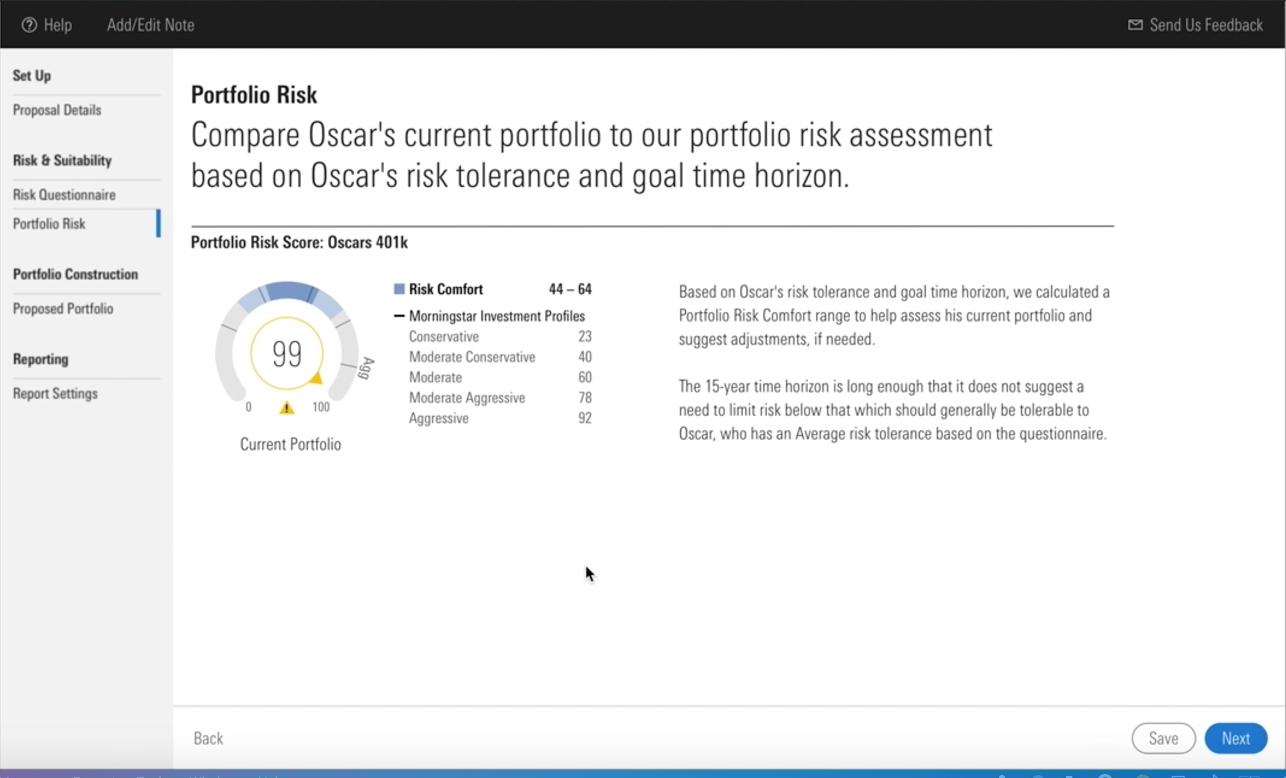3 min read
How to Measure and Manage Investment Risk

Risk assessments only work if they help advisors understand their clients’ true appetite for risk and then match them to appropriate investments. But with an unreliable risk profiler, you might be moving your client into an unsuitable portfolio.
The output of traditional risk profiles typically squeezes investors into one of five or six investment profile bands, which may limit what combination of products you can recommend.
You know that your client isn’t exactly like the other investors in that band—they have their own goals, timelines, and preferences. Yet you may be limited in your ability to truly personalize a portfolio for them.
Most investment profiles include some sort of asset allocation target, but many ignore variations within asset classes. Maybe your target is a 60/40 stock/bond portfolio, but is your stock sleeve allocated to small or large caps? Growth or value? Developed markets or emerging? Are the bonds in high-yield or government instruments?
Morningstar’s Portfolio Risk Score is a powerful tool to measure and compare investment risks at a holdings level, so you can more confidently find the right fit. Unlock new ways to personalize portfolios with our efficient, reliable risk assessment.
Types of Portfolio Risk
Financial advisors need to stay on top of several sources of investment risk to ensure that portfolios remain in line with their clients' appetite for risk. Here are a few examples.
Volatility Risk
Liquidity Risk
Liquidity risk is the risk that an investor or a fund might not be able to buy or sell an investment quickly enough. If there's not enough demand for an asset, it's more difficult for portfolio managers to convert it to cash at a fair value. That could lead to losses from selling an asset at an unfavorable price. For example, mutual funds and exchange-traded funds have low liquidity risk because they can be bought or sold daily. On the other hand, semiliquid funds can only be bought or sold at certain intervals by design.
Interest Rate Risk
Interest rate risk is the risk that higher interest rates in the future will lower the price of existing bonds because newer ones are issued with higher yields. Interest rate risk is important for bond portfolios, especially ones that hold bonds with longer durations.
How Do You Measure Portfolio Risk?
Morningstar’s Portfolio Risk Score can help you determine how much risk your client is currently taking in their accounts versus our own industry benchmarks, the Morningstar Target Allocation Indexes.
The five indexes capture the collective wisdom of the market’s target asset allocation fund managers. They give you a consistent, unbiased way to compare multi-asset portfolios and locate your clients’ accounts on a spectrum from conservative to aggressive.
Using our robust, holdings-based risk model, we can look under the hood of each index and every client account. Create a volatility profile based on over 30 factors to get a clear picture of each account’s risk—based on the actual underlying investments, not just the asset allocation. We can then indicate a risk level for each one using the indexes as reference points.
Here’s how you could use the Portfolio Risk Score to create an investment proposal.

Proposal tool showing how investment recommendations affect overall portfolio risk.
Imagine you have a client who wants to roll over his 401(k). As a mid-career professional, he has 15 years or more before he plans to withdraw money from his account.
Let’s start by looking at the makeup of his current 401(k), which in this case has a Portfolio Risk Score of 99, meaning it’s riskier than even Morningstar’s most aggressive profile benchmark, which scores 92. Is this too aggressive for your client?
Let’s find out. With the Morningstar Profiler risk tolerance questionnaire, you can stress-test how much risk your client can tolerate. This psychometric assessment will compare your client's answers against a carefully controlled data set of more than two million other completions.

Tool comparing the amount of risk in a client's portfolio to their tolerance of risk.
Say based on his responses, your client falls into the Average risk-tolerance group. His personalized Risk Comfort Range between 44 and 64—well below his current 401(k) risk score of 99. Your client needs to take some risk off the table to stay in his comfort range and meet his long-term goals.
With Morningstar’s interactive portfolio construction tool, you can choose securities from our vast investment universe database or your firm’s product shelf and then test how different investment allocations affect the overall risk score of your proposed portfolio.
You can also pick one of your firm’s model portfolios that falls in the client’s comfort range or allocate to multiple models to build a portfolio that fits.
For your mid-career client, you might build a portfolio with a Risk Score of 52, between Morningstar’s moderate-conservative or moderate benchmarks.
The dial visual makes it easy for clients to understand the changes between their original portfolio and your proposal, so you can show clients how you tailored your recommendations to meet their goals and preferences.

Evaluating investments for client risk tolerance.
A New Way to Explain Investment Risk
Investing will always come with risk. Using the Portfolio Risk Score and Risk Comfort Range, you can start meaningful conversations with clients. Illustrate their current risk exposure, the amount of risk they should be taking, and how your recommendations can better fit their needs.


